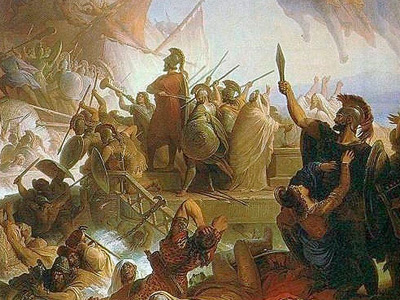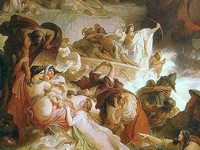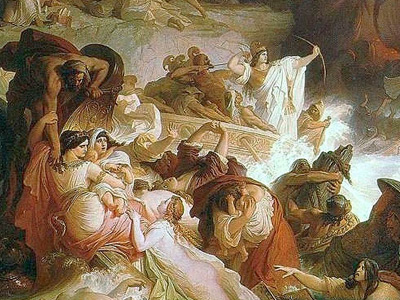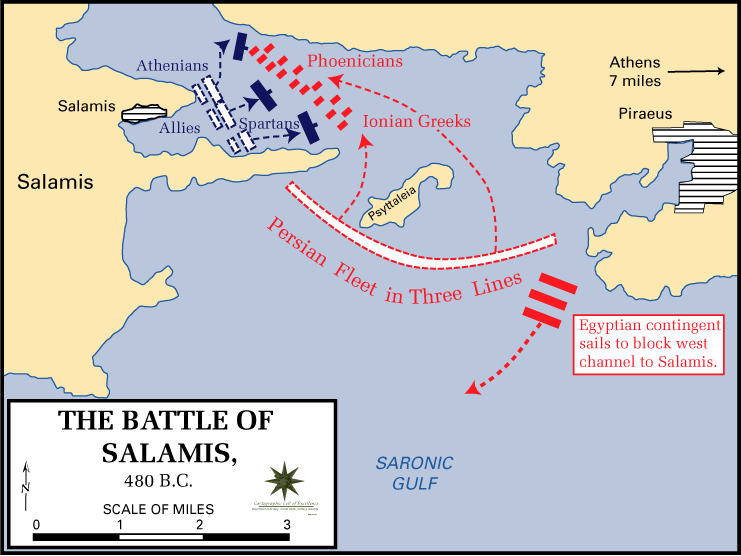Battle of Salamis (480 BC)

The Opposing Forces
The Greek fleet
Herodotus reports that there were 378 triremes in the Allied fleet, and then breaks the numbers down by city state. However, his numbers for the individual contingents only add up to 371. He does not explicitly say that all 378 fought at Salamis ("All of these came to the war providing triremes...The total number of ships...was three hundred and seventy-eight"), and he also says that the Aeginetans "had other manned ships, but they guarded their own land with these and fought at Salamis with the thirty most seaworthy". Thus it has been supposed that the difference between the numbers is accounted for a garrison of 12 ships left at Aegina. According to Herodotus, two more ships defected from the Persians to the Greeks, one before Artemisium and one before Salamis, so the total complement at Salamis would have been 373 (or 380).
According to the Athenian playwright Aeschylus, who actually fought at Salamis, the Greek fleet numbered 310 triremes (the difference being the number of Athenian ships). Ctesias claims that the Athenian fleet numbered only 110 triremes, which ties in with Aeschylus's numbers. According to Hyperides, the Greek fleet numbered only 220. The fleet was effectively under the command of Themistocles, but nominally led by the Spartan nobleman Eurybiades, as had been agreed at the congress in 481 BC. Although Themistocles had tried to claim leadership of the fleet, the other city states with navies objected, and so Sparta (which had no naval tradition) was given command of the fleet as a compromise.
The Persian fleet
According to Herodotus, the Persian fleet initially numbered 1,207 triremes. However, by his reckoning they lost approximately a third of these ships in a storm off the coast of Magnesia, 200 more in a storm off the coast of Euboea, and at least 50 ships to Allied action at the Battle of Artemisium. Herodotus claims that these losses were replaced in full, but only mentions 120 ships from the Greeks of Thrace and nearby islands as reinforcements. Aeschylus, who fought at Salamis, also claims that he faced 1,207 warships there, of which 207 were "fast ships". Diodorus and Lysias independently claim there were 1,200 ships in the Persian fleet assembled at Doriskos in the spring of 480 BC. The number of 1,207 (for the outset only) is also given by Ephorus, while his teacher Isocrates claims there were 1,300 at Doriskos and 1,200 at Salamis. Ctesias gives another number, 1,000 ships, while Plato, speaking in general terms refers to 1,000 ships and more.
The number 1,207 appears very early in the historical record (472 BC), and the Greeks appear to have genuinely believed they faced that many ships. Because of the consistency in the ancient sources, some modern historians are inclined to accept 1,207 as the size of the initial Persian fleet; others reject this number, with 1,207 being seen as more of a reference to the combined Greek fleet in the Iliad, and generally claim that the Persians could have launched no more than around 600 warships into the Aegean. However, very few appear to accept that there were this many ships at Salamis: most favour a number in the range 600-800. This is also the range given by adding the approximate number of Persian ships after Artemisium (~550) to the reinforcements (120) quantified by Herodotus.
HISTORY

RESOURCES
This article uses material from the Wikipedia article "Battle of Salamis", which is released under the Creative Commons Attribution-Share-Alike License 3.0.
© Stories Preschool. All Rights Reserved.










